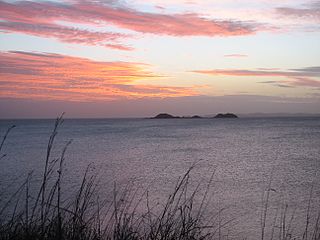Notes and references
Notes
- 1 2 3 Sharp 1992, p. 15.
Related Research Articles

Seisia is a coastal town and a locality in the Northern Peninsula Area Region, Queensland, Australia. In the 2021 census, the locality of Seisia had a population of 293 people.

The Injinoo were an Indigenous Australian people of the Cape York Peninsula, and their name now applies to a tribal aggregation of remnants of various tribes of the Cape York Peninsula.

The Djagaraga or Gudang are an Australian Aboriginal tribe, traditionally lived in the coastal area from Cape York to Fly point, including also Pabaju, in the Cape York Peninsula, Queensland. In the early period of white settlement as the Somerset tribe, after the settlement of Somerset established on their lands in 1863.
The Yir-Yoront, also known as the Yir Yiront, are an Indigenous Australian people of the Cape York Peninsula now living mostly in Kowanyama but also in Lirrqar/Pormpuraaw, both towns outside their traditional lands.

Kaurareg is the name for one of the Indigenous Australian groups collectively known as Torres Strait Islander peoples, although many or most identify as Aboriginal Australians. They are the traditional owners of Thursday Island (Waiben) as well as a number of Torres Strait Islands.
The Unduyamo (Andooyomo) were an indigenous Australian people who once lived around the northern shore of Newcastle Bay, Cape York Peninsula Queensland. It has been hypothesized that, among other aspects of their life, they functioned as religious specialists for Torres Strait Islanders, whose mastery of increase rituals attracted the native mariners from the north. Together with the Gudang, who apparently spoke the same language and whose territory ran from Cape York to Fly Point opposite Pabaju, the Unduyamo had strong cultural, kin and trade ties with the Kaurareg, the southwestern islanders centered on Muralag, with whom they enjoyed an alliance that permitted reciprocal residence on each other's territory. All three groups regarded the Yadhaigana and Gumakudin as hostile.
The Ayapathu people, otherwise known as the Ayabadhu or Aiyaboto, were an Indigenous Australian group, living on the western side of the Cape York Peninsula in northern Queensland.
The Barungguan are an Aboriginal Australian people of the Cape York Peninsula of Northern Queensland. The name is associated with three languages: Ganganda, Umpithamu and Morrobolam.

The Uutaalnganu people, also known as Night Island Kawadji, are an Aboriginal Australian group of Cape York Peninsula in northern Queensland. The name is also used collectively for several peoples in this area, such as the Pontunj / Jangkonj (Yanganyu), whose language is unconfirmed.
The Umpila people are an Aboriginal Australian people of the eastern Cape York Peninsula in northern Queensland. The majority of the remnant of the Umpila now live in Lockhart.
The Lama Lama, also spelt Lamalama, are a contemporary Aboriginal Australian people of the eastern Cape York Peninsula in northern Queensland. The term was formerly used as one of the ethnonyms associated with a distinct tribe or clan group, the Bakanambia. They are today an aggregation of remnants of several former tribes or clan groups.
The Yadhaykenu, otherwise known as the Jathaikana or Yadhaigana, are an Australian aboriginal tribe of northern Queensland. The name appears to be an exonym from the Western and Central Torres Strait yadaigal "talkers, chatterers,people who speak a lot".

Umagico is a town and coastal locality in the Northern Peninsula Area Region, Queensland, Australia. In the 2021 census, the locality of Umagico had a population of 394 people.
The Ajabakan were an indigenous Australian people of the Cape York Peninsula of Queensland.
The Mutumui were an indigenous Australian people of northern Queensland.
The Dingaal people, also known as Walmbarddha or Walmbaria, are an Aboriginal Australian people of Cape York Peninsula in northern Queensland.
The Unjadi (Unyadi) were an indigenous Australian people of the Cape York Peninsula of northern Queensland.
The Atjinuri were an indigenous Australian people of the Cape York Peninsula of Queensland.
The Wik Epa, also spelt Wikepa, are an Aboriginal Australian people, one of the Wik peoples of the Cape York Peninsula of northern Queensland.
References
- Sharp, Nonie (1992). Footprints Along the Cape York Sandbeaches. Aboriginal Studies Press. ISBN 978-0-855-75230-9.